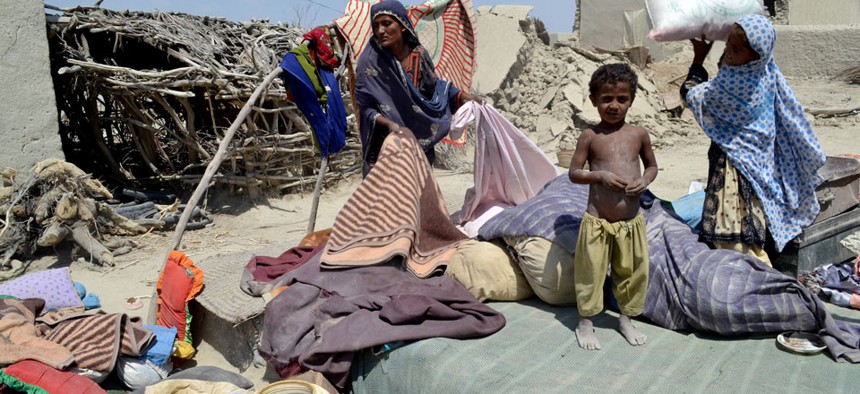Your iPhone: A Cutting-Edge Earthquake Detector?

Pakistani villagers collect belongings from their destroyed homes following an earthquake in Labach, Pakistan. Arshad Butt/AP
You may be holding the key to better preparedness -- right in your pocket.
When you grow up in California, "earthquake drills" are as common as fire drills. A teacher announces the presence of a quake. She may simulate, unconvincingly, the shaking of walls and windows and shelves. At that point, and as quickly as possible, you crawl under your desk, crouching and collecting yourself into a ball and covering, as much as you can, your head and neck. The idea is to take up as little space as possible so that toppling ceilings won't topple onto you. The further idea is to use the rest of your body to protect the part of it that is at once the most delicate and the most important: your brain.
The drills emphasize speed above all else, because, of course, earthquakes have a terrible tendency to strike at any moment. "Earthquake prediction" has long been a goal of seismologists; it's been largely, however, a quixotic one. The new island created in Pakistan last week, and the quake in Sichuan this spring -- and, of course, the devastation that struck Haiti and Japan in years past -- are, among so much else, reminders of how instant and destructive earthquakes can be. Hurricanes, tornadoes, and floods, for all their horrors, at least give some warning of their coming; earthquakes, in general, are guests that are not only uninvited, but unannounced.
There's reason to think, however, that humans will soon have a leg up when it comes to anticipating, and reacting to, earthquakes. And that's because of the little computers we carry around in our pockets. Smartphones and tablets have accelerometers built into them -- the little chips that help the phone distinguish between up and down, reorienting its screen for its user. Those chips, essentially the same technology that allow automotive airbags to work, detect and record a device's movements at granular levels of detail. Which is another way of saying that an increasingly large portion of humanity is carrying extremely sensitive motion-detection technology around with them every day, and at pretty much every moment.
Scientists, smartly, are looking to take advantage of that. Over at UC Berkeley, a team of researchers has been developing an app that will work with a phone's accelerometer to record the shaking that takes place during quakes -- and, then, to aggregate that information. (Their project is similar to the Community Seismic Network being run out of CalTech, except that it focuses on apps rather than purpose-built seismometers.) The phones, working in tandem, could theoretically detect the P-waves -- primary waves -- that move more quickly than the S-waves -- secondary waves -- during an earthquake. (P-waves are why dogs are known to show distress right before an earthquake: They feel the P-waves, it seems, in a way humans don't.)
Since it's the S-waves that tend to be the most destructive during an earthquake, the little bit of warning time that would result could be extremely valuable. It wouldn't be enough to evacuate an impact area before a quake hits; it might, however, be enough to give, say, surgeons a "stop operating" warning, or pilots an "abort landing" message. Or to give non-patients and non-passengers time to take cover under a table or in a doorway.
A phone-based network might also prove valuable once, and even after, an earthquake has hit. Antonino D'Alessandro and Giuseppe D'Anna, seismologists at the Istituto Nazionale di Geosifica e Vulcanologia in earthquake-prone Italy, have been testing whether inexpensive MEMS accelerometers, in particular -- yep, the ones that are found in iPhones -- can reliably detect the motion of an earthquake. Their finding? They can. At least, when the earthquakes in question are greater than a magnitude 5 (moderate to strong) on the Richter scale, and when the accelerometers are located near the quakes' epicenters. (Smaller quakes are harder to detect because of the "noise" that results from the fact that phones, in a real-world setting, are regularly jostled and tilted, making it hard to distinguish between the tremors of an earthquake and those of everyday life.)
D'Alessandro and D'Anna have published the results of their research in the October issue of the Bulletin of the Seismological Society of America. And their findings, they say, are particularly relevant to urban areas, which marry both a concentration of smartphones and a tendency to be especially ravaged by quakes. The idea would be to take advantage of accelerometers' geographical density to increase the amount of strong motion data that can be collected during a large earthquake -- to create, essentially, a "real-time urban seismic network." Not only, the thinking goes, would seismologists benefit from the resulting data about how earthquakes strike; the information would also allow first responders to quickly assess the impact of earthquakes and allocate resources accordingly. Our smartphones would make us smarter -- or, at least, better equipped to outwit nature.
This story first appeared at TheAtlantic.com
NEXT STORY: EPA Wants to Help You Sell Your Used Car



